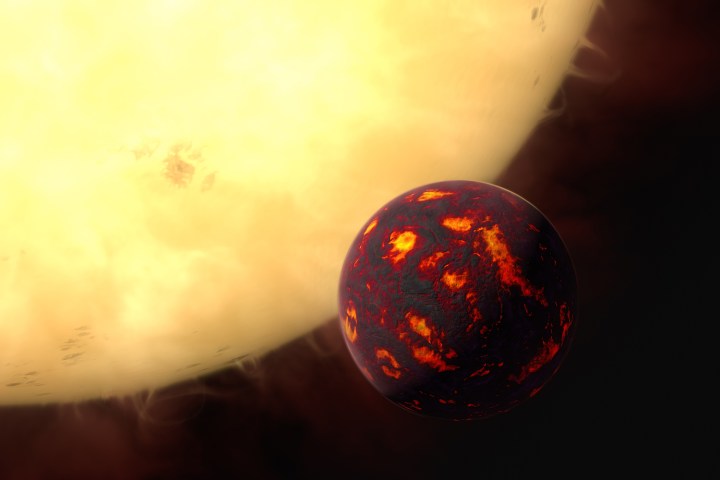
Located in a solar system roughly 40 light-years from Earth, 55 Cancri e is one of several planets orbiting 55 Cancri, a sun-like star called “Copernicus.” Dubbed “Janssen” by the International Astronomical Union, 55 Cancri e was initially discovered in 2004 and represents one of the first super-Earth type planets found by astronomers. Years before the Kepler space telescope made finding exoplanets an absolute breeze, astronomers instead used the traditional radial velocity technique to discover distant planetary systems, including the one containing Copernicus and Janssen.
What made 55 Cancri e so special upon its discovery was that it was also one of the first rocky planets to orbit a sequence star similar to our sun. Though in comparison to its mass Earth is little more than a pipsqueak, compared to other giant gaseous planets within our solar system, Janssen (along with all super-Earths) is relatively small.
“This is a very exciting result because it’s the first time that we have been able to find the spectral fingerprints that show the gases present in the atmosphere of a super-Earth,” says UCL PhD student Angelos Tsiaras. “Our observations of 55 Cancri e’s atmosphere suggest that the planet has managed to cling on to a significant amount of hydrogen and helium from the nebula from which it formed.”
Tsiaras, along with UCL Physics & Astronomy’s Dr. Ingo Waldmann and Marco Rocchetto, developed a new data processing technique for NASA and the European Space Agency’s Hubble Space Telescope which allowed them to examine Janssen’s atmosphere with “unprecedented detail.” By utilizing this novel technique, astronomers gained the ability to essentially tease data concerning a planet’s atmosphere out of readings obtained by Hubble. Moreover, the inherent brightness of Copernicus further aided in the astronomers’ ability to obtain information pertaining to Janssen.
The accrued data then allowed the researchers to deduce what exactly Janssen’s atmosphere contained (its helium and hydrogen makeup), and also fostered the creation of the theory that its high-density core could be diamond-like. Considering the star formed some 8 billion years ago (and orbits so close to a star), the astronomers are shocked it has maintained an atmosphere for as long as it has. Additionally, the recorded data also indicated a hydrogen cyanide signature, likely meaning 55 Cancri e’s atmosphere is carbon-rich.
“If the presence of hydrogen cyanide and other molecules is confirmed in a few years time by the next generation of infrared telescopes, it would support the theory that this planet is indeed carbon rich and a very exotic place,” says UCL professor Jonathan Tennyson. “Although, hydrogen cyanide or prussic acid is highly poisonous, so it is perhaps not a planet I would like to live on!”
So while 55 Cancri e isn’t necessarily paradise waiting in the wings, the discovery of its atmosphere stands as an incredible advance toward discovering Earth-like planets in the future. Currently, astronomers lack the necessary telescope to discover such planets, however, with the launch of the James Webb Space Telescope scheduled for 2018, such a capability isn’t terribly far off.
Editors' Recommendations
- Exoplanet discoveries include two super-Earths that could support life
- Hubble space telescope finds water vapor on ‘Super-Earth’ exoplanet


